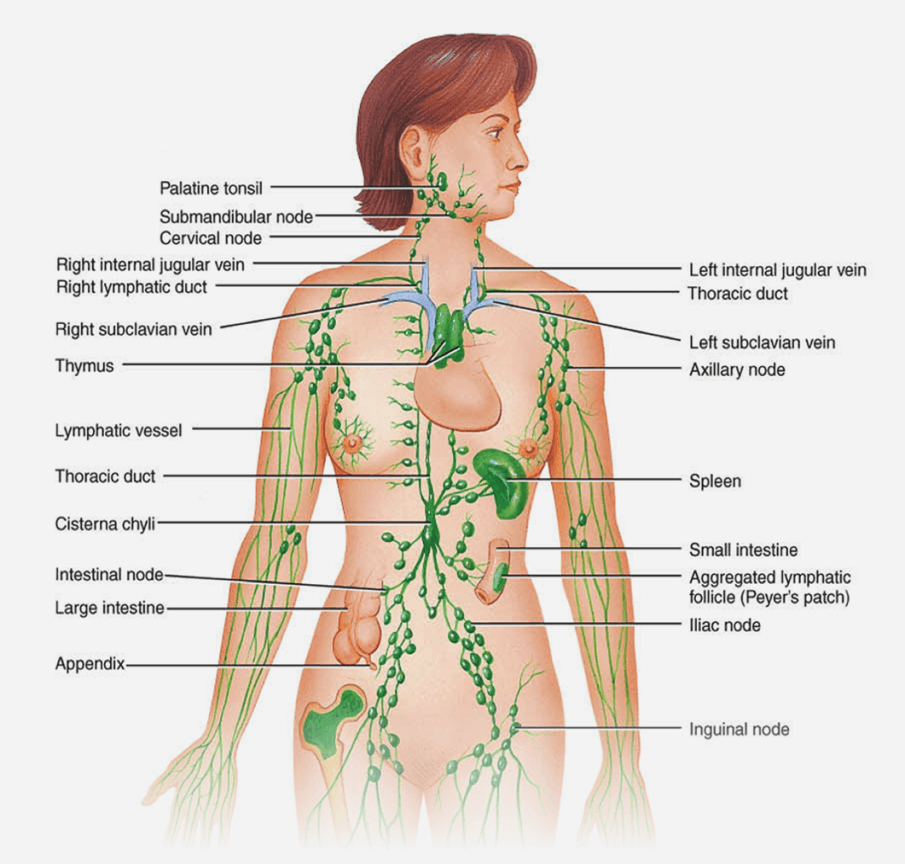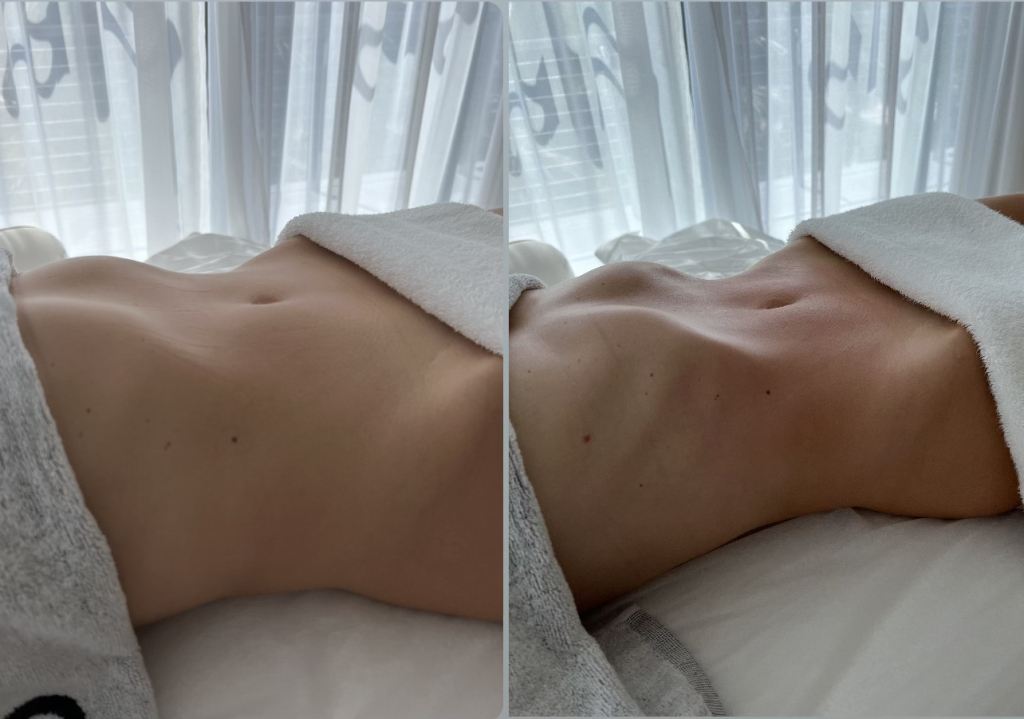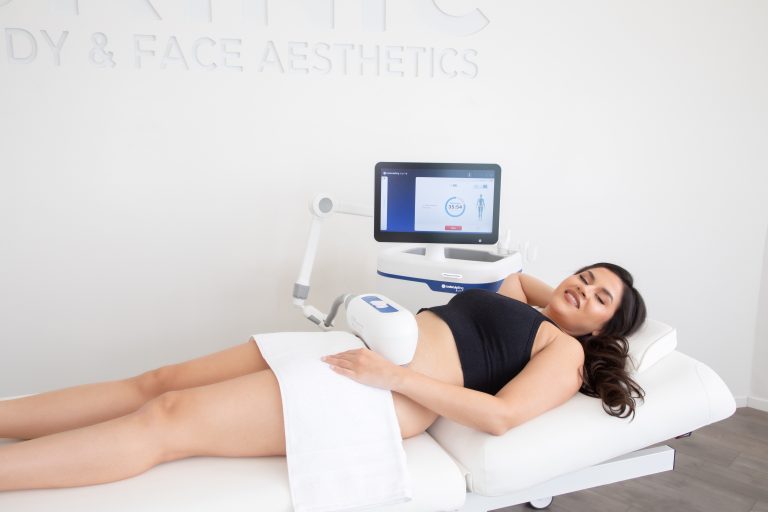
- October 8, 2022
- by Skinic
Lymphatic Drainage Massage. The Complete Guide.
Lymphatic drainage massages seem to be the slimming treatment du jour with so many people raving about its benefits. In addition to eliminating excess fluids, reducing bloating due to liquid retention, lymphatic drainage has other benefits for your health. It boosts immunity and helps the body process and eliminate fat, reducing the appearance of cellulite. Also, it’s gentle and relaxing, unlike deep tissue massages. You can slim down, improve your health and experience a soothing massage at the same time. Maybe that’s why so many people are booking lymphatic drainage massages.
To understand why these massages are so effective, it helps to get to know a little about the lymphatic system and how it works. We’ll explore the lymphatic system, its main functions and components so you can get a clearer picture of why the lymphatic drainage massage is not only a slimming treatment, but also a boost to health and well-being.
What is the lymphatic system?

The lymphatic system is part of the body’s immune, digestive and endocrine systems. Composed of a network of lymphatic vessels, lymph nodes, organs and tissues, including bone marrow, the thymus gland, the spleen, and the small intestine, it is essential for fat and liquid absorption, balanced hormones and the body’s ability to fight infection by ridding it of toxins, including cancer-causing pathogens.
A well-functioning lymphatic system is essential for health, being a key player in the body’s immune response and the prevention of disease. When people refer to a “sluggish lymphatic system” they are usually referring to a buildup of liquids and toxins, leading to a feeling of malaise, physical and mental fatigue, and uncomfortable bloating. When the lymphatic system is working optimally, it can lead to feeling more energetic, more slimmed down due to fluid removal and even increased mental clarity.
What are the main components of the lymphatic system?
To better understand how the lymphatic works, let’s take an in-depth look at each of its main components and what they do:
- Lymph – Lymph is a clear fluid which leaks into the tissues after the cardiovascular system sends blood to the tissues and organs. This lymph is then carried through the body via lymphatic vessels and nodes towards the upper body to be drained. When this process isn’t working properly, the result is swelling in the extremities.
- Lymph capillaries – Located throughout the body, these tiny vessels are responsible for the uptake of lymph which then gets carried to the larger lymphatic vessels.
- Lymphatic vessels – The lymph capillaries transfer the lymph into these muscular vessels which pulsate as they pump lymph through the body. Their valve systems also prevent it from flowing backwards.
- Lymph nodes – Our bodies have approximately 700 lymph nodes located in the neck, breasts, armpits, lower back, pelvis, groin, and knees. They process toxins and swell when the body is under infection.
- Lymphocytes – Otherwise known as white blood cells, lymphocytes include T cells and B cells that detect viruses, bacteria and harmful substances in the lymph fluid and lymph nodes. They are responsible for generating antibodies to fight infections.
- Thymus gland – A small gland about the size of a thumb located behind the sternum, the thymus gland is part of the endocrine systems, responsible for hormone production as well as the production of infection-fighting T cells.
- Spleen – Located between the stomach and the diaphragm on the left side of the body, the spleen filters the blood, removes toxins and produces white blood cells while destroying and filtering damaged red blood cells.
- Tonsils – The tonsils produce lymphocytes and antibodies and are a line of defense against toxic particles that are airborne or that are swallowed.
- Macrophanges – Nicknamed the pathogen trash collectors, these cells identify pathogens and essentially eat them, destroying their ability to cause damage.
- Peyer patches – Located in the lining of the small intestine, these clusters of lymphoid follicles house various immune cells such as macrophanges, T cells and B cells. Peyer patches detect pathogens and activate the body’s immune response to fend them off. Most people have 30-40 Peyer patches in their small intestines. Some viruses and pathogens are able to hack the Peyer patches’ defense system, such as the ones that cause Crohn’s disease, ulcerative colitis, E.coli and salmonella infections, polio and HIV.
- Bone marrow – The bone marrow houses B cells that are essential to the body’s immune response.
As you can see, the lymphatic system is a large network that is designed to support the body in filtering pathogens and removing them from the body before they can cause harm. A healthy functioning lymphatic system means enhanced immunity and better health.
What are the main functions of the lymphatic system?
The lymphatic system is primarily responsible for supporting the body’s immune response, however it also is essential for promoting fat absorption and balancing fluids in the body.
- Immune function – The lymphatic system detects toxins and pathogens in the body and activates the production and circulation of white blood cells, T cells and B cells to fight infection and prevent the onset of potentially fatal diseases such as cancer.
- Fat absorption – The lymphatic system plays an important role in absorbing fat and fat-soluble vitamins from the digestive system and then transporting these substances to the rest of the body. While most other nutrients are absorbed by blood capillaries in the small intestine, fat is absorbed by lymph capillaries, called lacteals. The lymph located in the lacteals is called chyle and has a high fat content, making it white in appearance. A healthy lymphatic system helps the body transport and metabolize fat efficiently. When the lymphatic system is not working optimally, it can result in the accumulation of fat in the form of cellulite.
- Fluid balance – Our blood vessels deliver nutrients by way of fluids to the body’s tissues. When these fluids leak into the tissues, they are then picked up by lymphatic vessels, draining the fluids from the tissues and carrying it through the body to be drained from the area under the collarbones. Lymph that has been carried from the legs, stomach, left arm and chest is drained under the left collarbone. Lymph that was carried from the right arm, face and an area of the right chest is drained under the right collarbone. When the lymph vessels don’t pick up and drain the excess liquids in the tissues, blood pressure drops and the limbs swell due to liquid retention, called edema. Though not technically a medical condition, edema is uncomfortable and can make your muscles feel stiff and achy as well as cause bloating and puffiness in the body and face. Conditions such as secondary lymphoedema, however, usually caused by scar tissue as a result of surgery, removal of lymph nodes or radiotherapy can have chronic long-term swelling that can become so painful it’s disabling.
A poorly functioning lymphatic system can eventually lead to the development of conditions and diseases, some of them very serious. These conditions include:
- Glandular fever
- Tonsilitis
- Crohn’s disease
- Hodgkin’s disease
- Primary lymphoedema
- Secondary lymphoedema
How does lifestyle affect the lymphatic system?
There are many factors that contribute to the health of the lymphatic system. As the lymphatic system depends on pressure in the body to remove lymph and process and eliminate toxins, activities that make this process more efficient are:
- Exercise – During exercise, blood flow increases and as blood flow increases, so does the movement of lymph through the body. The more efficiently lymph moves through the body, the more quickly it can remove excess liquids and get rid of pathogens.
- Hydrate – Drink plenty of water and your lymphatic system will thank you. One of the things that contributes to a sluggish lymphatic system is dehydration. When your body is hydrated, it creates pressure that forces the blood vessels and lymph vessels to pump more efficiently. When you are dehydrated, it’s more likely for liquids to pool in the tissues, causing swelling.
- Limit the consumption of caffeine and alcohol – Beverages containing caffeine and alcohol dehydrate you, making the circulation of lymph sluggish and causing liquid retention.
- Avoid exposure to toxins – Avoiding overloading the body with toxins, whether from environmental factors or from ingesting unhealthy and processed foods, will allow its immune response to protect the body. When there are too many toxins to fight, the body becomes overloaded and illness is the result.
- Avoid salty foods – Salty foods cause liquid retention which makes it harder for the lymphatic system to remove fluids from the body.
- Receive lymphatic drainage massages – Lymphatic drainage massage stimulates the lymphatic system and supports the flow of lymph through the body so it can be drained more efficiently.
What is Lymphatic Drainage massage?
Lymphatic drainage massage is a treatment that was developed in 1932 by French massage therapist Emil Vodder and naturopath Estrid Vodder. Through their study of the lymphatic system and its vessels, they produced a new type of gentle massage style that was designed to aid the flow of lymph through the body. They called their invention “Manual Lymph Drainage.” They taught the MLD technique at centers throughout Europe and eventually the treatment migrated to the U.S.
The technique uses upward massage strokes that gently pushes the lymph to its drainage point under the collarbones.
What are the benefits of Lymphatic Drainage massage?
A lymphatic drainage massage is one of the most beneficial styles of massages for our health and bodies. Just some of its benefits include:
- Boosting the immune system by supporting the removal of toxins
- Reducing water retention and the resulting bloating and puffiness by eliminating excess liquid stored in the tissues.
- Reducing the appearance of cellulite by supporting the lymphatic system’s function of fat absorption and processing.
- Improving skin tone by reducing liquid retention and fat deposits.
- Slims the body as fluids are eliminated and fat is processed more efficiently.
- Improves digestion as it supports the small intestine’s functioning.
- Provides a sense of relaxation with its gentle and nurturing strokes.

How do lymphatic drainage massages work?
Since the lymphatic system is part of our body’s immune system whose main activity is moving lymph through the circulatory system to rid our bodies of toxins, getting a lymphatic drainage massage helps to manually move the lymph along its natural path so it can work more efficiently. While you’ll notice the effect it has on eliminating excess liquid stored in the tissues, reducing bloating and puffiness, the massage will also work to support your immune system’s functioning, so that you can enjoy a both a healthier and more shapely body.
In addition to the gentle upward stroke, the massage therapist will apply light pressure to the lymph nodes, massaging the knees, the groin, the abdomen, the chest, armpits and neck and other areas where the lymph nodes are located. They will notice if the lymph nodes are swollen to the touch. Also, if the tissues are swollen, they will see the skin change color as the fluids are released from the tissues and pressure is released in that area. They will constantly be moving their strokes upward, following the lymphatic system’s natural trajectory of drainage under the collarbones.
Lymphatic drainage massages are different from deep tissue massage in that the therapist doesn’t need to work deeply into the muscles, but rather works on the tissues closer to the surface. Lymphatic drainage massages won’t cause redness or bruising but rather provide a relaxing experience. Clients report feeling a sense of release and relaxation and noticeably reduced swelling in their limbs after a lymphatic drainage massage. The results can be seen immediately with clients looking slimmer and less bloated.
What should I do after a lymphatic drainage massage?
While the lymphatic drainage massage in itself is a complete body therapy, there are some things you can do after your massage to maximize its benefits and make sure the positive effects last even longer:
- Drink plenty of water – your massage therapist has just worked for an hour or more to move the lymph through your circulatory system. When you hydrate after a massage, you potentialize the effects and keep up the momentum that was gained during the massage.
- Eat a light meal – go easy on your body after a lymphatic drainage massage. Though the strokes are gentle, there is some deep work being done. Give your body the chance to process it and avoid overwhelming your digestive system with a heavy meal.
- Do some very light exercise – Just as drinking water will help your body move and process lymph more efficiently, moving your body will have the same effect by stimulating your circulatory system. Some light yoga or Pilates or a short walk can maximize the effects of the massage. No need to overdo it and go all out. Think if it as a continuation of the slow and gentle detoxification process started with the massage.
- Get a good night’s rest – It’s possible you may feel a little tired after receiving a lymphatic drainage massage. That’s completely normal as your body’s energy is concentrated on the detoxification process its undergoing. Get to bed early if you can and enjoy a deep rest. The relaxing quality of the massage should calm your nervous system and help carry you into bedtime.
Are there any contraindications for lymphatic drainage?
Lymphatic drainage is a gentle and safe treatment for almost everyone with great health benefits such as boosting the body’s immunity, getting rid of toxins, removing excess fluids and reducing bloating. However, people with certain conditions should not receive a lymphatic drainage massage as they may complicate their conditions:
- Heart condition
- Kidney failure
- Blood clots
- Infection
If you’re unsure if a lymphatic drainage massage is right for you, consult one of our professionals at Skinic, Beverly Hills to find out the best treatment(s) for you.
Are lymphatic drainage massages painful?
A lymphatic drainage massage shouldn’t be painful. The pressure is consistent and fluid but shouldn’t be so deep as to leave marks unless your skin is very sensitive.
For most people, a lymphatic drainage massage is an enjoyable and relaxing experience that helps to calm the nerves and quiet thoughts, along with all the other excellent health benefits.
What other types of massages support lymphatic drainage?
Miracle Sculpt
A standard lymphatic drainage massage focuses on gentle strokes and stimulating the removal of fluids. However, massages such as Miracle Sculpt, by Skinic, Beverly Hills, combines lymphatic drainage with shaping massage to offer a 2-in-1 treatment that provides both the water retention and detoxification of the lymphatic drainage massage AND the fat reduction of the shaping massage.
Miracle Sculpt is described as a “manual liposculpture.” Using a patented series of rhythmic suction and massaging strokes, Miracle Sculpt drains excess liquid while breaking up stubborn fat deposits. Miracle Sculpt also provides body contouring to give the body a shapelier silhouette.
Though similar to a lymphatic drainage massage in that it reduces swelling caused by water retention, Miracle Sculpt has the added benefit of working on areas of stored fat as well. The suctioning maneuvers break up the fat deposits while the massage strokes push the fat deposits and retained water through the body so they can be eliminated by the lymphatic system, helping the body get rid of both excess fat and liquids.
While many shaping massages use quite firm strokes that can cause sensitivity and bruising, Miracle Sculpt uses lighter strokes, so clients won’t have to endure a painful massage to reap the benefits. Also, shaping massages tend to focus on the areas where fat accumulates, such as the buttocks, abdomen and thighs, but Miracle Sculpt offers a whole-body massage to move lymph through the body while focusing part of the massage on the “problem areas” mentioned above to break up fat deposits.
Since the lymphatic system is also responsible for the body’s fat absorption, this is a perfect combination. While the body’s lymphatic system is supported and stimulated by the massage, it can more efficiently process the fat broken up by the shaping massage. Miracle Sculpt will reduce puffiness and result in more even skin tone and more defined muscles. It’s also one of the most effective and gentle massages for reducing the appearance of cellulite.
| Lymphatic Drainage Massage | Miracle Sculpt | |
| Reduces bloating | ||
| Removes toxins | ||
| Reduces inflammation | ||
| Improves circulation | ||
| Improves appearance of cellulite | ||
| Breaks up stubborn fat | ||
| Body contouring |
Velashape 3
Velashape 3 is a treatment that targets fat cells. In this treatment, the technician uses a hand-held device and rolls it over your skin. The device’s vacuum pulls the skin up, loosening the connective fibers that cause cellulite while massage rollers knead the skin and underlying fat to recontour your body. Though the target is fat cells, the suctioning and roller stimulate the release of fluids held in the tissues, supporting lymphatic drainage.
The device also uses infrared light and radiofrequency to target fat cells, causing them to shrink so you not only get cellulite reduction and contouring, you get circumference reduction as well.
Velashape 3 is a non-invasive procedure that takes only 30 minutes per session. You can get as many sessions as you need to get your desired results and our trained technicians at Skinic can help evaluate your treatment plan based on your goals.
Some clients feel a warming sensation as the infrared light melts the fat cells. Depending on how sensitive your skin is, you may also experience some redness which will go away in a short time.
As this is a quick, non-invasive treatment, there’s no downtime.
Coupling Velashape 3 with lymphatic drainage massage or Miracle Sculpt will enhance both fat reduction and liquid retention. As the fat melted in VelaShape 3 needs to be eliminated through the lymphatic system, a lymphatic drainage massage will speed this process while eliminating excess liquids stored in the tissues, maximizing overall weight loss and resulting in a drastically slimmed down body.
How often should I get a lymphatic drainage massage?
You almost can’t have too many lymphatic drainage massages. They are so gentle, yet so beneficial that having one every other day would be a treat for your body to maximize results and speed up the process of liquid drainage. After that you can maintain your results with weekly, bi-weekly or monthly massages according to your needs and goals.
Conclusion
There is good reason why lymphatic drainage is on the rise among the health and beauty-conscious. Its numerous health benefits coupled with its effect of eliminating bloating and puffiness through a relaxing massage technique have made it a popular treatment at spas across the US and Europe. Other techniques such as Miracle Sculpt offers a new twists on a classic massage technique, contact us to learn more about it.

